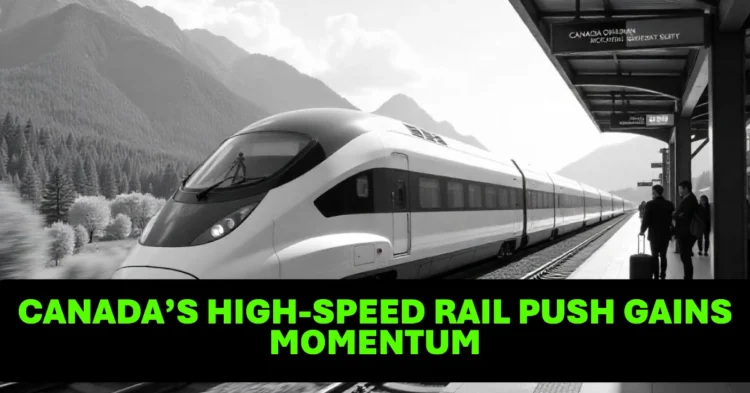Canada is no longer just dreaming about high-speed rail—it’s building it. A transformative infrastructure project is gaining momentum, one that promises to change how Canadians travel, boost tourism, and challenge short-haul air travel across major cities.
After years of speculation, the reality is finally setting in. Tracks are being planned. Timelines are taking shape. Public interest is surging. This isn’t some distant vision—it’s happening now.
Table of Contents
Why High-Speed Rail Matters More Than Ever
From Idea to Action
Until recently, high-speed rail in Canada lived mostly in political speeches and engineering studies. But now, several key factors have collided to fast-track this initiative.
Air travel delays, environmental pressure, and demand for regional connectivity have created the perfect storm. Suddenly, high-speed rail isn’t just an alternative—it’s a necessity.
More Than Just Speed
Sure, speed matters—imagine traveling from Toronto to Montreal in under three hours. But this project is about more than minutes saved. It’s about rethinking accessibility, sustainability, and economic equity across regions.
Game-Changer for Tourism and Travel
Shorter Trips, Bigger Opportunities
High-speed rail collapses distance. Weekend getaways from Ottawa to Quebec City become effortless. Day trips that once required flights are now possible by train. The psychological barrier to domestic travel shrinks with every kilometer of track.
More Visitors, More Local Growth
Greater access means more hotel bookings, restaurant traffic, and cultural tourism. Smaller cities and towns once overlooked by air travelers stand to benefit enormously. With central stations replacing remote airports, entire regions become more inviting to explore.
A Major Threat to Domestic Air Travel
Airlines Under Pressure
Short-haul flights have long dominated intercity travel in Canada. But long waits, security checks, and rising fares are wearing on passengers. High-speed rail offers a smoother, simpler option—boarding in the city center and arriving right in the heart of another.
Features Designed for the Modern Traveler
Onboard Wi-Fi, quiet cars, café services, and comfortable workspaces make rail an attractive alternative for business and leisure travelers alike. Combined with competitive pricing and reliable schedules, the appeal is clear.
Sustainable Travel Is the Future
A Greener Way to Go
Unlike traditional transportation modes, the high-speed rail system is set to run on electric power. That translates to fewer emissions, lower environmental impact, and alignment with Canada’s ambitious climate targets.
Eco-Conscious Choices for the Conscious Traveler
With sustainability now central to travel decisions, especially among younger generations, rail becomes the go-to choice for those who want guilt-free exploration without sacrificing convenience or comfort.
Economic Impact: More Than Just Tracks
Jobs, Construction, and Long-Term Careers
The immediate boost? Thousands of construction and engineering jobs. The long-term effect? Permanent positions in train operations, station maintenance, tourism support, and more.
Revitalizing Local Economies
Stations in or near smaller communities will drive local investment. Hotels, retail shops, restaurants, and tour services will emerge to meet the demands of new travelers. The result is a more balanced tourism economy and stronger regional development.
Key Players in Canada’s Rail Landscape
While high-speed rail is the new frontier, Canada’s rail network is already diverse. Here’s a quick overview of existing services:
Passenger and Commuter Rail:
- VIA Rail: National passenger service, especially strong in the Quebec City–Windsor corridor.
- GO Transit: Commuter trains serving the Greater Toronto Area.
- Exo: Regional transit network in the Montreal metropolitan area.
- Capital Railway (O-Train) and REM: Light rail systems in Ottawa and Montreal, respectively.
Scenic and Tourism-Oriented Rail:
- Rocky Mountaineer: Luxury train through the Canadian Rockies.
- Agawa Canyon Tour Train and Alberta Prairie Railway: Heritage and scenic routes.
Indigenous and Regional Lines:
- Keewatin Railway and Ontario Northland: Vital lifelines for northern and Indigenous communities.
The Road (or Track) Ahead
Rollout Plans and Route Details
The first phase targets the Quebec City–Montreal–Ottawa–Toronto corridor, with phased construction and service introductions. Future expansions could include connections to Western Canada or the Maritimes.
Stations will be modern, digitally integrated, and strategically located for easy access. Ticket pricing aims to undercut short-haul flights while appealing to both business and leisure markets.
Amenities to Expect
From high-speed Wi-Fi and café cars to business-friendly seating and streamlined ticketing, the high-speed rail experience will be built around passenger needs and modern expectations.
Challenges to Overcome
Infrastructure and Political Hurdles
Large-scale infrastructure projects are never without obstacles. High construction costs, land-use issues, and inter-provincial coordination all pose risks. However, growing public demand and environmental urgency continue to drive the conversation forward.
Rising Investment and Public Support
With greater interest from both private investors and federal partners, the path is becoming clearer. The economic, environmental, and societal benefits make a compelling case for moving forward.
A New Era of Canadian Mobility Begins
Canada’s high-speed rail project is more than a transportation upgrade—it’s a shift in national identity.
It’s about making Canadian travel faster, smarter, and greener. It’s about inviting people to explore more of their country without the obstacles of long travel times or high airfares. It’s about reconnecting regions and rethinking what’s possible.
As the rails are laid, a new era begins—not just for trains, but for Canadian tourism, economy, and connectivity.

